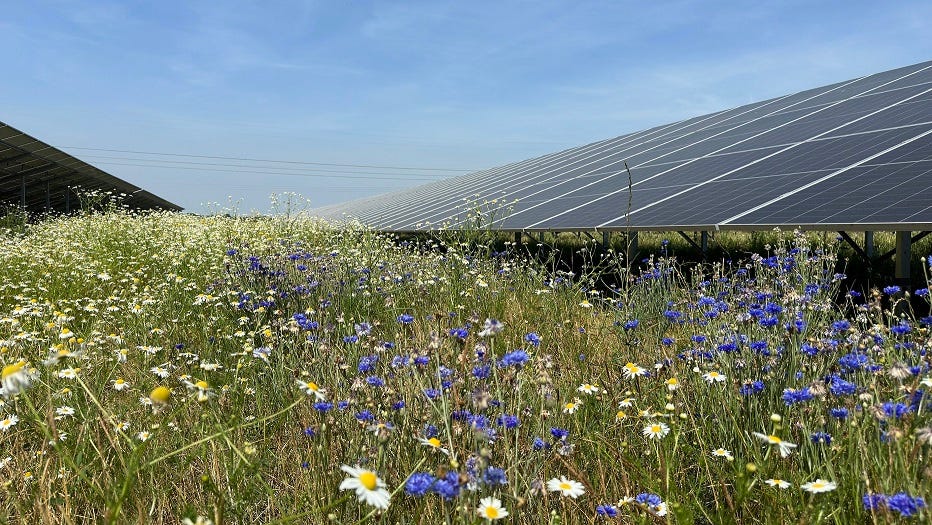The Weekly Anthropocene, July 24 2024
China hits its 2030 renewables target 6.5 years early, rhino rewilding in South Africa, R21 malaria vaccines in Côte d’Ivoire, Thailand has more tigers, a solar meadow in Hungary, and more!
United States
Capping an extraordinary administration of epochal policy victories (highlights include the Bipartisan Infrastructure Law, AUKUS, heroic defense of Ukraine, Bipartisan Safer Communities Act, NATO expansion, Inflation Reduction Act, CHIPS and Science Act, JAROKUS, and Respect for Marriage Act), U.S. President Joe Biden has cemented his legacy as a truly selfless great American leader by stepping aside as his party's nominee and endorsing Vice President Kamala Harris for the 2024 election.
This newsletter has long been a fervent supporter of Biden, but his advanced age and deteriorating communication skills had become an increasing political liability in the last few months, and it's a refreshing and exciting move to revitalize and redefine the presidential race1 with Vice President Harris as a new standard-bearer. Needless to say, this newsletter heartily endorses Kamala to carry on the Biden-Harris legacy and lead us forward. Spectacular news!
China
It’s barely getting coverage in U.S. media, but China is in the middle of an unprecedentedly massive clean energy buildout. Chinese solar and wind deployment has been breaking all records for years in a row, and it’s still accelerating.
“In the first five months of 2024, China has added some 79GW of solar and 20GW of wind. These additions are up 29% and 21% respectively from last year’s numbers, which were already record-breaking.”
-CarbonBrief
It is almost incomprehensible how ridiculously vast an amount of electricity-generating capacity we’re talking about, and how ridiculously fast it got built.
As one headline put it, “China is installing the wind and solar equivalent of five large nuclear power stations per week.”
A recent report indicates that China may meet its renewables installation target for 2030 by the end of July 2024, six and a half years early.
For context, the U.S. EIA reports that at the end of 2022, the entire United States had about 1,200 GW of total electricity generating capacity, every solar farm and coal plant and hydroelectric dam and everything added together. China just added nearly 100 GW of wind and solar alone in five months.
All this clean energy growth has pushed coal down to providing a record-low 53% of China’s electricity in May 2024, down from 60% in May 2023.
Solar and wind together provided a record-high 23% of China’s electricity in May 2024, up from 7% in May 2016.
And electric vehicles accounted for about 40% of all cars sold in China in May 2024 as well, as China continues to produce lots of cheap, efficient EVs.
As renewables continue to grow rapidly, it’s looking more and more likely that China’s carbon emissions may have peaked in 2023! This is truly extraordinary news for the future of the entire planet.
South Africa
As this newsletter has previously reported, renowned NGO African Parks unexpectedly acquired 2,000 white rhinos (Ceratotherium simum) last year due to the dissolution of a large private ranch. Now, 120 of those white rhinos have been successfully rewilded to the Greater Kruger landscape of South Africa, where they will strengthen the local rhino population ranging across 2.5 million hectares of unfenced wildlands forming a network of public and private reserves. Notably, all “rewildees” have been dehorned and equipped with trackers before release to reduce poaching risk. Great work!
“The rhino will come in dehorned, which is a very effective way to decrease the poaching risk in this landscape. We’re at a point where this risk is well calculated…
This will be the first re-introduction of rhino into this landscape in about 50 years.”
-Markus Hofmeyr, wildlife vet.
Côte d’Ivoire
The world-historic R21 malaria vaccine is now being administered to children in the West African nation of Côte d’Ivoire (aka Ivory Coast), with the first doses received on July 15 in the first steps of a national plan to vaccinate 250,000 kids under the age of 2. Many other African countries will start deploying R21 soon as well!
This R21 malaria vaccine is a true masterpiece of medicine, costing less than $4 per dose and boasting a 75 to 80% efficacy rate in young children. The Serum Institute of India has already manufactured 25 million doses of R21 and has pledged to eventually make 100 million doses per year. We’re seeing nothing less than the dawn of an epic civilizational triumph here: hundreds of thousands of children die from malaria each year, almost all in sub-Saharan Africa, but now humanity finally has the tools to defeat this ancient enemy! Absolutely splendid news.
Saudi Arabia
Jinko Solar, one of China’s seven solar supergiants, is leading a consortium to build a giant 10 GW solar cell module factory in Saudi Arabia. (Terminology check: many solar cells form a solar module, many solar modules form a solar panel, many solar panels form a solar array). Another example of the increasingly worldwide reach of the civilization transition to clean energy!
Thailand

A new study has found tiger populations are on the rise in the western forests of Thailand, with a round of surveys concluding in November 2023 photographing 94 individual tigers, up from 75 the previous year and less than 40 in 2007. This is particularly good news as Cambodia, Vietnam, and Laos have lost all their tigers to poaching since 2010, making Thailand a vital stronghold. Fortunately, savvy conservation efforts (Thailand has a very large and professional ranger force) and growing prey populations (wild sambar deer and banteng cattle numbers are on the rise) have created a welcoming landscape for tigers. in the Huai Kha Khaeng Wildlife Sanctuary, the largest reserve in Thailand’s western forests and a former research site of the late great Dr. Alan Rabinowitz, tiger populations now appear to be growing at an average of 4% per year. This broader landscape may soon help repopulate other parts of Southeast Asia; tigers already seem to be dispersing across the border into Myanmar. Great news!
Hungary
The 138 MW Lumen Park Szolnok was built in central Hungary by SolSystems with the explicit goal of serving as a model wildlife-friendly solar farm, with wildflower seeds sown on the site (formerly farmland) and bat, bird, and bee houses placed among the panels2. PV Magazine now reports that ecological monitoring recorded 23 bird species visited the park in 2023, its first year of operation, with the common pheasant and crested lark starting to nest in the area since the solar panels were installed. Rare plants such as sea arrowgrass and saltmarsh buttercup have also appeared, buzzards and kestrels are seen more often than before, and new bird species such as bluethroats and linnets have arrived.
This fascinating new finding exemplifies an emerging global trend, with similar studies arriving recently from Chile and Slovakia3. With a little care and attention, photovoltaic installations can form “solar meadow” havens for biodiversity while generating clean electrons at the same time! There’s lots of space for more research and experimentation with this win-win solution.
“Unburdened by what has been,” so to speak.
SolSystems even published a best practices guide in English on what they learned while doing it, available as “Professional Guide for the Development of Next-Generation Solar Parks.”
A little while ago, this newsletter reported on a study of 32 solar parks in Slovakia that found that utility-scale solar brings substantial benefits to local bird species, with bird species diversity and numbers higher in the solar parks than in control land plots. The solar panel support structures and vegetation under the panels served as prime nesting sites, and the parks may also be helpful as winter migration stopovers by providing snow-free space under the panels.












Starting my day out right reading awesome news about the malaria vaccine rollout. Thanks Sam!
China is moving so rapidly into leadership positions in clean energy and ev's, it's bewildering. It's sad to see America falling into second place so rapidly on so many fronts but what China is doing is good for the environment so one has to content themselves with that, I suppose.